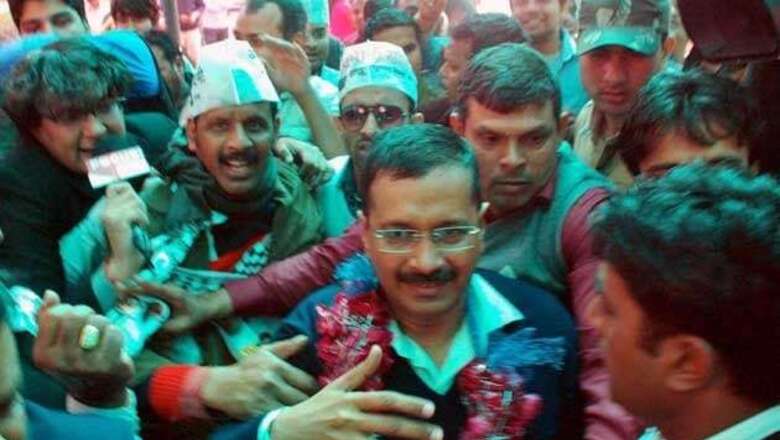
views
New Delhi: Arvind Kejriwal's love affair with Delhi will resume on Valentine's Day at the Ramlila Maidan, a place which initially catapulted him to the national stage during Anna Hazare's anti-corruption movement in 2011, when he takes oath as the ninth Chief Minister of the national capital exactly a year after he hastily resigned from the post and then made a disastrous bid to enter national politics with Lok Sabha elections.
After single-handedly leading his Aam Aadmi Party to a earth shattering victory in Delhi Assembly elections where his two-year-old outfit won an astounding 67 seats in the 70-member Delhi Assembly despite facing the might of Bharatiya Janata Party and Central government led by Prime Minister Narendra Modi, Kejriwal will once again get the charge to implement his anti-corruption agenda along with promises of slashing water and electricity tariff, ensuring women's safety, seeking full statehood for Delhi and making the life of underprivileged better.
So decisive has been AAP's victory that BJP barely managed to win three seats, rendering the party ineligible to even stake the claim for the Leader of Opposition in the Assembly. Kejriwal stole two of Modi's biggest slogans - Swachh Bharat Abhiyan and Congress Mukt Bharat - by clean bowling the Grand Old Party of Indian for a duck and snatching its vote bank to deliver the knockout punch to BJP.
In fact AAP's strike rate of almost 96 per cent has just one parallel in India's electoral history. Only Pawan Chamling's Sikkim Democratic Front (SDF) won 31 of the 32 Assembly seats in the Himalayan state in 2004 and five years later went one better making a clean sweep of all the seats.
While the 2015 Delhi Assembly elections have been almost mirrored the Sikkim scoreline but there is a significant difference. In Sikkim Chamling's path was full of roses due to the total absence of a credible opposition but in the national capital Kejriwal's AAP was fighting against a party which had not suffered any major electoral setback in over two years and was on a high after its superlative show in the 2014 Lok Sabha elections.
In a replay of the mythical David vs Goliath battle, it was once again the former which triumphed against insurmountable odds. An election machinery led by the Prime Minister of India, BJP President Amit Shah and including 120 MPs, over 20 Central Ministers along with chief ministers of 10 states was expected to steamroll the puny-sized AAP which started with several handicaps, the most noticeable being lack of funds.
But nothing had prepared the BJP and its top leaders for the kind of positive campaign undertaken by Kejriwal's AAP which relied on personal contact, door-to-door campaign, street corner meetings and taking up of local issues which concern a voter daily.
Smug in the belief that Modi wave was still active in the country, BJP took a top heavy approach by relying on Shah's strategy to target Kejriwal, often hitting him below the belt, using its firepower to level accusations instead of coming up with its version of how to make Delhi a better place and making him the centre of the election campaign. BJP's Delhi unit has been a deeply fractured house for the last few years and in order to overcome this obstacle, Shah's initial strategy was to use the Modi card to lure the Delhi voter.
Yet after the January 10 Modi rally which turned out to be a damp squib, BJP changed the plan and hurriedly brought India's first IPS officer Kiran Bedi into the party to take on his one-time associate Kejriwal. The move was very unlike Modi who believes in leading from the front.
With Modi taking the backseat, a confused and clueless BJP with an equally inept chief ministerial candidate took on Kejriwal who had been slogging it out on the streets of Delhi for nearly six months seeking forgiveness for quitting as the chief minister after just 49 days and trying to regain the voters trust.
Bedi's drafting only deepened divisions within the BJP while her poor oratorical and man management skills only compounded the problems. Faced with a pugnacious, street smart politician in Kejriwal, Bedi was soon floundering forcing her party to once again bank on the Modi charisma.
But Modi's four rallies neither galvanised the voters nor his party and the writing was on the wall.
Kejriwal became the centre of Delhi elections just like Modi was during the Lok Sabha campaign. He mastered the same strategy BJP had used a few months earlier. Facing a massive army of big names, Kejriwal succeeded in painting himself as a lone ranger who took on the high and mighty and also empathised with the "aam aadmi" unlike his rivals who talked of big national and international issues but failed to come up with blueprint for Delhi.
While it became clear that BJP was trailing, the extent of AAP's clean sweep could not be gauged. But on February 7, the voters gave a decisive mandate in favour of Kejriwal and when EVMs were unsealed three days later, AAP's broom generated a massive dust storm which blew away BJP's lotus.
In the end it is #5SaalKejriwal that triumphed over "Dilli Chale Modi ke Saath".



















Comments
0 comment